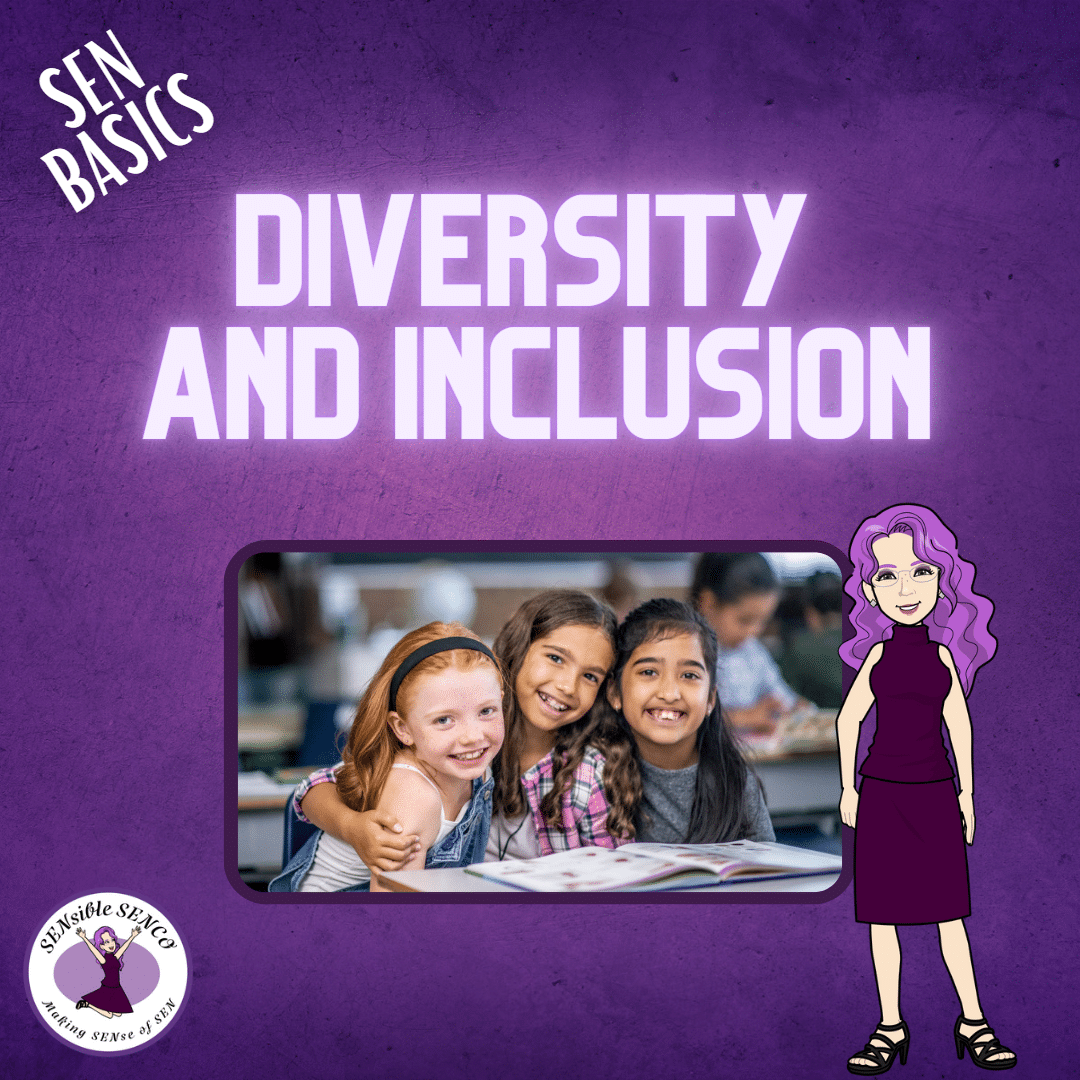Diversity and Inclusion for SENCOs: Strategies for Promoting Equity in the UK
Introduction
Diversity refers to the recognition and celebration of the differences among individuals, including but not limited to their race, ethnicity, gender, religion, socio-economic status, and abilities. Inclusion, on the other hand, focuses on creating an environment where everyone feels valued, respected, and supported, and their diverse needs are met.
Promoting diversity and inclusion in the education system is essential for several reasons. Firstly, it helps foster a sense of belonging among students, creating a positive learning environment. Secondly, it prepares students for the real world by exposing them to different perspectives and experiences. Finally, it enhances educational outcomes by catering to the diverse learning needs of students.
SENCOs are educational professionals who specialise in supporting students with special educational needs. Their role is to ensure that these students receive the necessary accommodations and support to succeed academically and socially. SENCOs work closely with teachers, parents, and external professionals to develop individualised education plans and create inclusive learning environments for students with special educational needs.
Understanding the Challenges
Unconscious Bias: Unconscious bias refers to the automatic associations and stereotypes that people hold about certain groups, often without conscious awareness. It can impact decision-making processes, interactions, and opportunities in the education system. Recognising and addressing unconscious biases is crucial for creating a fair and inclusive environment.
Lack of Representation: The lack of representation in educational materials, including textbooks, curriculum content, and teaching resources, can perpetuate stereotypes and limit students’ exposure to diverse perspectives. It is important to ensure that educational materials reflect the diversity of the student population and include content that represents various cultures, ethnicities, genders, abilities, and backgrounds.
Inadequate Support Services: Limited availability of support services and resources for students with special educational needs can hinder their access to quality education. Schools need sufficient funding, trained staff, and appropriate accommodations to meet the diverse needs of all students. Adequate support services are crucial for promoting inclusivity and providing equal educational opportunities.
Barriers to Accessibility: Physical and attitudinal barriers can impede access to education for students with disabilities. Schools should prioritise creating accessible environments, including wheelchair ramps, assistive technologies, and inclusive teaching practices. Furthermore, fostering a culture of inclusivity and understanding can help break down attitudinal barriers and ensure that every student feels welcomed and valued.
Socio-economic Disparities: Socio-economic disparities can significantly impact educational opportunities and outcomes. Students from disadvantaged backgrounds may face barriers to accessing resources, extracurricular activities, and quality education. Addressing these disparities requires targeted interventions, such as providing additional support, scholarships, and inclusive programs to ensure equal opportunities for all students.
Language and Cultural Barriers: Students from diverse linguistic and cultural backgrounds may face challenges in fully participating and engaging in the education system. Schools should strive to provide language support, cultural sensitivity, and opportunities for students to express their cultural identities. Embracing multilingualism and multiculturalism enhances inclusivity and fosters a sense of belonging among students.
Resistance to Change: Implementing changes to promote diversity and inclusion can face resistance from various stakeholders, including educators, administrators, and parents. It is crucial to address concerns, provide clear communication, and engage stakeholders in the process. Building a shared understanding of the benefits of diversity and inclusion can help overcome resistance and foster a supportive environment.
Building an Inclusive Culture
Here are some strategies to foster an inclusive culture:
Promote Acceptance and Respect: Schools should actively promote acceptance and respect for all individuals, regardless of their background, race, ethnicity, gender, abilities, or beliefs. This can be achieved through school-wide campaigns, awareness programs, and ongoing discussions about diversity and inclusivity. By fostering a culture of acceptance, students develop empathy, appreciation for differences, and a sense of belonging.
Training and Awareness Programs: Providing training and awareness programs for teachers and staff is essential in developing their understanding of diversity and inclusion. These programs can cover topics such as cultural competence, unconscious bias, and inclusive teaching practices. By equipping educators with the knowledge and tools to create inclusive classrooms, they can better meet the diverse needs of their students.
Involve Parents and the Community: Engaging parents and the wider community is crucial for promoting diversity and inclusion. Schools can organise workshops, parent-teacher associations, and community events that celebrate different cultures, traditions, and perspectives. Collaboration with parents and the community helps create a shared responsibility for fostering an inclusive environment and strengthens relationships among all stakeholders.
Celebrate Diversity: Actively celebrating diversity reinforces the message that differences are valued and appreciated. Schools can organise multicultural events, international days, and heritage celebrations where students can showcase their unique backgrounds and traditions. This not only promotes cultural understanding but also allows students to develop a sense of pride in their own heritage while respecting and learning from others.
Inclusive Policies and Practices: Schools should establish inclusive policies and practices that promote equal opportunities for all students. This includes adopting anti-discrimination policies, implementing procedures for reporting and addressing bias incidents, and ensuring accessibility for students with disabilities. Clear guidelines and protocols ensure that all members of the school community understand the expectations and contribute to an inclusive culture.
Student Voice and Representation: Actively involving students in decision-making processes empowers them and provides a platform for their voices to be heard. Schools can establish student councils, diversity committees, or student-led initiatives that focus on promoting inclusivity. Providing opportunities for students to actively participate in shaping the school’s culture fosters a sense of ownership and empowers them to advocate for a more inclusive environment.
Professional Development for Staff: Offering professional development opportunities for staff members is crucial in supporting their growth as inclusive educators. Training sessions, workshops, and resources should be provided to enhance their knowledge of inclusive practices, teaching strategies for diverse learners, and creating a safe and respectful classroom environment. Ongoing professional development ensures that educators stay updated and continually improve their inclusive teaching approaches.
Inclusive Teaching Strategies
Differentiated Instruction: Differentiated instruction involves tailoring teaching approaches and content to meet the diverse learning needs of students. Educators can vary the instructional methods, materials, and assessments based on students’ abilities, interests, and learning styles. By providing differentiated instruction, teachers can accommodate varying paces of learning, individual preferences, and readiness levels.
Personalised Learning: Personalised learning focuses on tailoring instruction to address each student’s specific strengths, interests, and challenges. It involves creating individualised learning plans, setting goals, and providing opportunities for students to take ownership of their learning. Personalised learning allows students to progress at their own pace, engage in self-directed learning, and pursue areas of interest.
Universal Design for Learning (UDL): UDL is an approach that aims to provide multiple means of representation, engagement, and expression to meet the diverse needs of students. Educators can present information in various formats (e.g., visual, auditory, kinesthetic), offer choices for engagement and expression, and provide flexible learning environments. UDL ensures that all students have equal access to the curriculum and can demonstrate their learning in ways that work best for them.
Collaborative Learning: Collaborative learning encourages students to work together in groups, fostering peer-to-peer interactions and cooperative problem-solving. By engaging in collaborative activities, students learn from one another, develop social skills, and gain different perspectives. Educators can facilitate group discussions, assign group projects, and provide structured opportunities for collaboration to promote inclusive and cooperative learning environments.
Accessible Materials and Technology: Providing accessible materials and leveraging technology can enhance inclusivity in the classroom. Educators can utilise digital tools, assistive technologies, and captioned resources to ensure that students with disabilities have equal access to learning materials. Offering alternative formats, such as audio recordings or enlarged texts, supports students with visual impairments or learning difficulties.
Multimodal Instruction: Multimodal instruction involves presenting information through multiple sensory modalities, such as visual, auditory, and kinesthetic. This approach accommodates diverse learning styles and preferences. Educators can incorporate visual aids, videos, demonstrations, hands-on activities, and interactive discussions to engage students through different modalities, enhancing their understanding and retention of the content.
Regular Progress Monitoring and Feedback: Regularly monitoring student progress and providing constructive feedback are essential components of inclusive teaching. Educators can use formative assessments, check-ins, and observations to gauge student understanding and identify areas that require additional support. Providing timely feedback and offering opportunities for students to reflect on their learning promotes growth and improvement.
Culturally Responsive Teaching: Culturally responsive teaching acknowledges and incorporates students’ cultural backgrounds, experiences, and perspectives into the curriculum. Educators can integrate diverse cultural references, examples, and literature into their teaching. By valuing and respecting diverse cultures, students feel a sense of belonging and can see themselves reflected in the learning materials.
Collaborating with Stakeholders
SENCOs should work collaboratively with other educators and professionals to provide comprehensive support for students. This may include developing individualised education plans, coordinating specialised services, and sharing best practices. Engaging parents and guardians in the decision-making process is vital. Regular communication, parent-teacher conferences, and involving parents in school activities can help create a supportive partnership. Building partnerships with external organisations and support services can further enhance the support available to students with special educational needs.
Addressing Bias and Discrimination
SENCOs should encourage awareness and recognition of unconscious bias among teachers and staff. Training programs on cultural competence and anti-discrimination can help address biases and promote inclusivity. Implementing clear policies and procedures to prevent discrimination is essential. Schools should foster an environment where students feel safe to report any incidents of bias or discrimination. Taking proactive measures to tackle microaggressions, bias, and discrimination can contribute to an inclusive learning environment for all students.
Evaluating and Monitoring Progress
Establishing benchmarks and goals for diversity and inclusion helps track progress and identify areas for improvement. Schools can use various assessment tools, surveys, and feedback mechanisms to gather data and measure the impact of their strategies. Regularly assessing the effectiveness of strategies allows for adjustments and improvements based on feedback and data analysis.
It is crucial to involve all stakeholders, including students, teachers, parents, and community members, in the evaluation process. Their perspectives and input can provide valuable insights into the impact of diversity and inclusion initiatives. Schools can also seek external evaluation and accreditation to ensure accountability and transparency in their efforts.
Supporting Professional Development
Providing ongoing training and resources specific to supporting students with special educational needs is crucial. These training programs can cover topics such as inclusive teaching strategies, understanding different disabilities, and fostering a positive learning environment. SENCOs can also benefit from networking opportunities and sharing best practices with other professionals in the field. Encouraging continuous learning and self-reflection among SENCOs helps ensure they are equipped with the knowledge and skills to effectively promote equity in the UK education system.
Conclusion
Diversity and inclusion are not just buzzwords but essential values that contribute to better educational outcomes and a more inclusive society. As we continue to strive for a more equitable future, it is important for all stakeholders in the education system to work together to create a supportive and inclusive environment for every student.
FAQs
• Teachers can promote diversity and inclusion by incorporating diverse perspectives and experiences into the curriculum, using inclusive teaching methods, fostering a safe and respectful classroom environment, and addressing biases and stereotypes. They can also organize multicultural activities and encourage open discussions about diversity and inclusion.
2. What role do parents play in promoting diversity and inclusion in schools?
• Parents play a vital role in promoting diversity and inclusion by instilling values of acceptance and respect in their children, reinforcing the importance of diversity, collaborating with schools on diversity-related initiatives, and actively participating in parent-teacher associations and school activities focused on diversity and inclusion.
3. What resources are available to support SENCOs in their role?
• SENCOs can access various resources to support their role, including professional development programs, training workshops, online forums and communities, research articles and publications, and collaboration with other SENCOs and educational professionals. Additionally, they can seek guidance from educational organisations, government agencies, and support services specialising in special educational needs.
4. How can schools address unconscious bias among teachers and staff?
• Schools can address unconscious bias by providing awareness and training programs on cultural competence, diversity, and inclusion. This helps teachers and staff recognise their biases and develop strategies to mitigate their impact. Schools can also implement inclusive policies and procedures, foster open dialogue about bias, and encourage self-reflection and continuous learning.
5. What are some successful examples of inclusive education practices in the UK?
Some successful examples of inclusive education practices in the UK include implementing personalised learning approaches to meet individual student needs, establishing support systems and resources for students with special educational needs, promoting inclusive school cultures through awareness campaigns and diversity celebrations, and involving students in decision-making processes related to their education. Additionally, collaborations with external organisations and community involvement have proven effective in creating inclusive educational environments.
It is crucial to remember that promoting diversity and inclusion is an ongoing process that requires continuous effort and collaboration. By working together, educators, parents, and the community can create a supportive and inclusive educational ecosystem where every student feels valued, respected, and empowered to succeed.
If you have any further questions or need additional information, please feel free to comment below.
Together, let’s continue to promote diversity, inclusion, and equity in education, making a positive difference in the lives of students and society as a whole.
ents.

Abigail Hawkins FCCT
Director of SENDCO Solutions




